- General Dermatology
- Eczema
- Chronic Hand Eczema
- Alopecia
- Aesthetics
- Vitiligo
- COVID-19
- Actinic Keratosis
- Precision Medicine and Biologics
- Rare Disease
- Wound Care
- Rosacea
- Psoriasis
- Psoriatic Arthritis
- Atopic Dermatitis
- Melasma
- NP and PA
- Skin Cancer
- Hidradenitis Suppurativa
- Drug Watch
- Pigmentary Disorders
- Acne
- Pediatric Dermatology
- Practice Management
- Prurigo Nodularis
Article
Advances in wound healing tools and techniques
New wound-healing tools arising from evolving knowledge of the wound-healing process include drugs, debridement techniques, advanced skin grafting tools and stem cell delivery strategies.
Maui – Promising strategies to promote wound healing range from relatively straightforward drugs and debridement techniques to meticulous manipulation of skin grafts and donor sites, using techniques such as laser-assisted application of mesenchymal stem cells (MSCs), said an expert at MauiDerm 2015.
SEE PHOTOS: 43-year-old female with surgical wound
These new tools and techniques have arisen from dermatologists' ever-evolving concept of wound healing, said Robert S. Kirsner, M.D., Ph.D. He is chairman (interim) and Harvey Blank Professor, Department of Dermatology & Cutaneous Surgery; Professor of Epidemiology and Public Health; and Director of the Wound Center at the University of Miami Miller School of Medicine.
READ: Model predicts risk for delayed wound healing
In educating residents, his department emphasizes that many of the conditions they see actually involve wounds – though they may not realize it. Along with chronic skin ulcers, burns and traumatic injuries, Dr. Kirsner explained, everything from cancers and inflammatory conditions to genetic autoimmune diseases and drug reactions presents with wounding.
Versus general surgeons and plastic surgeons, he added, "We create three to six times as many wounds that we must repair. So we should know how to take care of those wounds."
SEE PHOTOS: 28-year-old female with sickle cell ulcer
To that end, Dr. Kirsner suggested viewing wounds along a continuum of healing outcomes. Between normal healing and chronic wounds lies a wide spectrum of abnormal healing. The Holy Grail, he added, is scarless healing, as occurs in fetuses during the first two trimesters of gestation.
NEXT: Stifling stress reactions
Stifling stress reactions
Indirectly, stressors such as anxiety, isolation and even postoperative pain can reduce wound-healing rates up to 40%.1 Such stressors release steroids, which stimulate the pituitary to release glucocorticoid hormones. These hormones diminish the amount of pro-healing cytokines such as interleukin (IL)-1, vascular endothelial growth factor (VEGF) and transformative growth factor beta (TGFb) available to reach the wound, Dr. Kirsner said.
READ: Fidgetin like 2 identified as promising wound healing target
Conversely, he said, physical and mental exercise, a positive attitude, social interaction and pain reduction all reduce stress, mediated by oxytocin. "Someday perhaps we'll be giving oxytocin to reduce stress and improve healing." For now, "consider creating a stress-free environment for our patients." This can include controlling operative and postoperative pain, he said, and perhaps postponing elective procedures if patients have recently experienced stressful life events.
Like steroids, catecholamines released during stress also delay healing. However, said Dr. Kirsner, the success of systemic propranolol in reducing childhood hemangiomas2 fueled the discovery that beta blockers block catecholamines – a mechanism that's proving useful in many indications. For instance, he said that in a well-done, randomized, controlled trial (RCT) involving 79 burn patients, those who received a systemic beta blocker healed faster (16.13 ± 7.4 days versus 21.52 ± 7.94 days, P = 0.004) than control-group patients.3
NEXT: 43-year-old female with open surgical wound

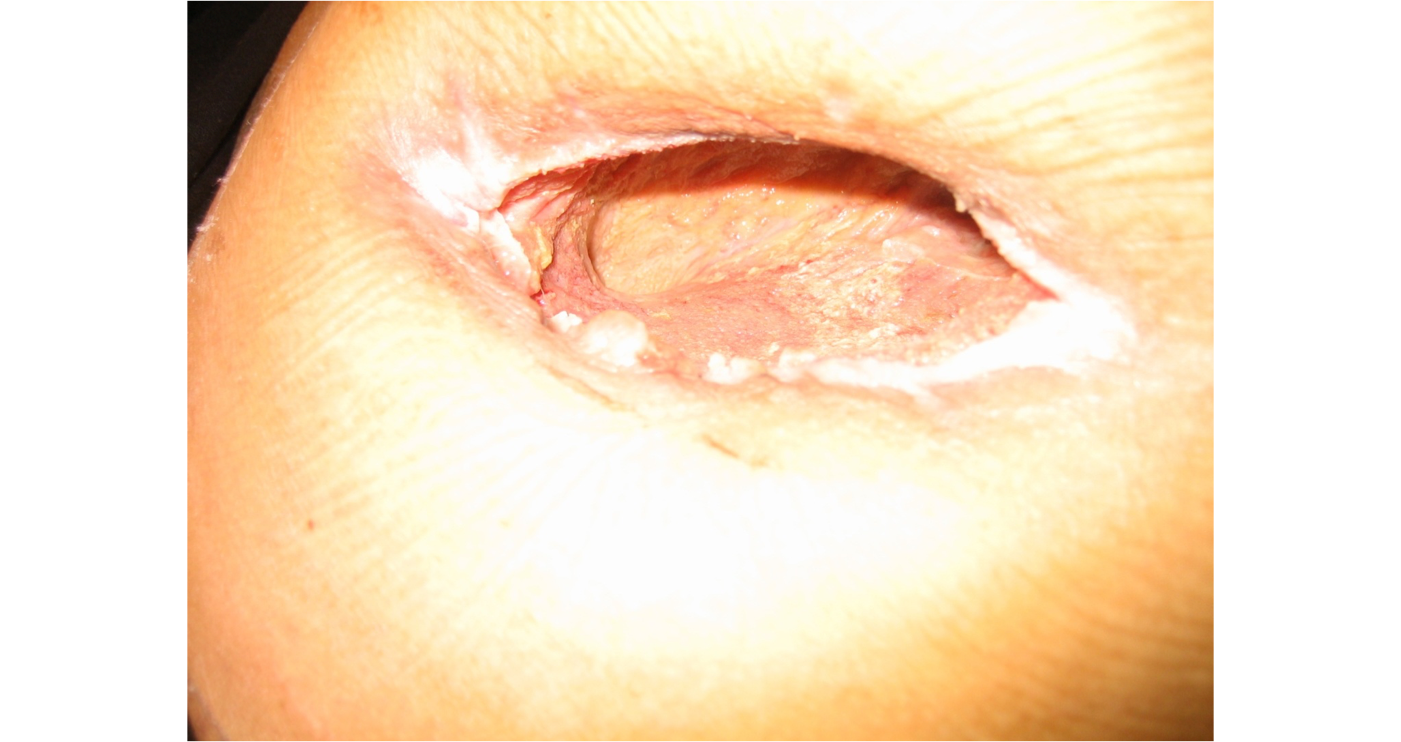

43-year-old female with chronic post-heart-transplant wound before (April 2010) and after (September 2010) approximately eight weeks' treatment with topical timolol.
The first use of beta blockers in healing chronic wounds involved a 43-year-old female with a persistent open surgical wound after her second heart transplant.4 With topical timolol 0.5 percent, said Dr. Kirsner, who treated her, the wound epithelialized in about eight weeks.
NEXT: Photos of eight week progression

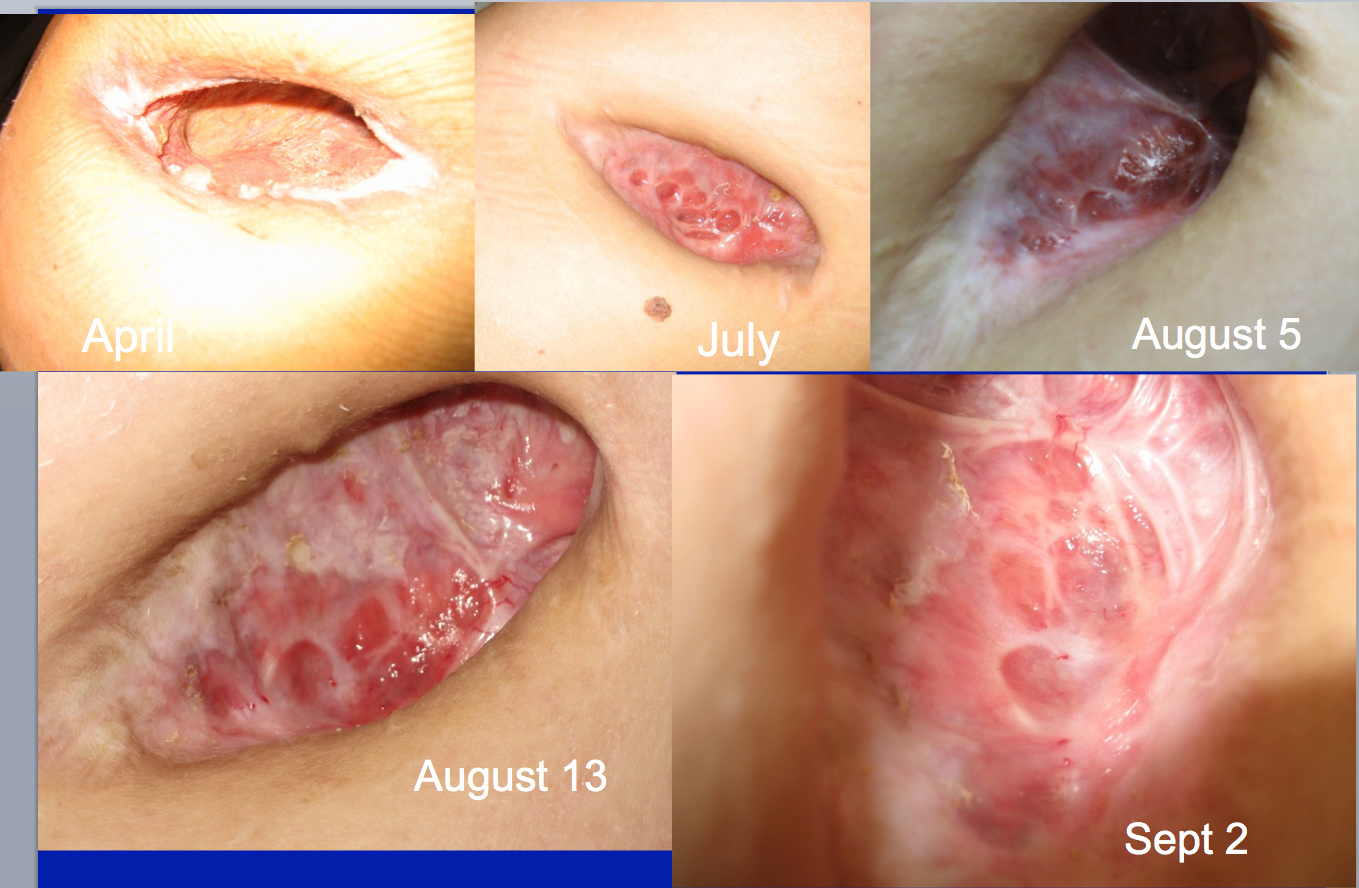

43-year-old female with chronic post-heart-transplant wound before (April 2010) and after (September 2010) approximately eight weeks' treatment with topical timolol.
More recently, he published a case series in which three of five diverse chronic wounds treated with topical timolol healed completely, and a fourth achieved dramatic improvement.5 "Not everybody does well. But beta blockers provide an opportunity to reverse previously nonhealing wounds."
Clinically, Dr. Kirsner uses topical timolol for modestly sized superficial wounds – to achieve not granulation but epithelialization. Since optimal dosing has not yet been determined, he added, "We use it consistent with the standard of care," which ranges from daily to weekly.
NEXT: SKIN grafting tools
Skin grafting tools
For skin grafting, the CelluTome Epidermal Harvesting System (Kinetic Concepts Inc./Acelity), commercially available in the United States and Europe, allows harvesting of epidermal grafts without creating donor-site scars. "You place this little device, without anesthesia, on the donor site (typically the inner thigh) for 20 to 45 minutes." Using suction, the device raises approximately 30 tiny microdomes of epidermis. Pressing a lever shears all the grafts off, so they can be placed on a wound-dressing sheet. "Then you transfer those little pieces of epidermis onto the wound. When you put them in culture on patients' skin, the keratinocytes migrate out of the microdomes" to speed wound healing.6
Specifically, said Dr. Kirsner, the micrografts deliver growth factors to the wound, resulting in edge advancement. Confocal microscopy moreover has shown that the grafts indeed "take" where they're planted, resulting in dots of new epidermis across the wound surface, he said. Because the process also transfers melanocytes, it works for vitiligo as well. At the donor site, "You can't even tell anything was done two days later."
READ: ‘Bad’ molecules found to be good for wound healing
The fact that the CelluTome creates very little donor-site inflammation also makes it helpful in addressing wounds left by pyoderma gangrenosum, after appropriate pharmaceutical treatment,7 and perhaps in other conditions wherein inflammation contraindicates conventional skin grafting, he said.
Because the procedure creates minimal donor-site disruption and is easy to perform, Dr. Kirsner has used it in other indications including sickle cell ulcers and nonhealing wounds in an elderly male treated for several squamous cell carcinomas.
Conversely, the Xpansion Micro-Autografting Kit (SteadMed/Applied Tissue Technologies) minces harvested skin to create 0.8 mm x 0.8 mm split-thickness skin grafts that can cover an area 100 times the size of the original graft. Because there's no need to orient the micrografts dermal side down, said Dr. Kirsner, "Those cells 'take,' or flip over, on their own," boosting the wound's healing capability.
READ: Stem cells, lasers poised to join woundcare armamentarium
Somewhat similarly, he said, using hair-transplantation techniques provides better stimulation of wound healing than traditional pinch biopsy techniques, perhaps because hair follicles contain factors such as stem cells. Presently, Dr. Kirsner and his colleagues are studying the interface between hair follicles and wound healing. "We believe that they share many of the same mechanisms, and some of the information and hair biology that we've learned from hair diseases can be applied to wounds."
To improve the quality of conventional skin grafts, Dr. Kirsner added, "pre-wounding" donor-area skin appears helpful.8 In two patients with chronic leg ulceration, "We took pinch biopsies, creating wounds, but didn't harvest the skin. We covered it for three days, which turned on the healing process in the grafts, then transferred them onto wounds." Pre-wounded grafts achieved marked improvement in ulcer-bed granulation tissue, and increased edge advancement.
NEXT: Debridement: Go big
Debridement: go big
Although debridement represents the standard of care for chronic wounds, Dr. Kirsner said, wound-healing specialists have long debated how extensively one should debride. Based on a series of 312,774 chronic wounds, "It turns out, the more you debride, the better."9
NEXT: Nanotechnology accelerates wound healing
Biopsies have shown that debridement removes key factors – including c-Myc and nuclear expression of beta-catenin – that prevent keratinocytes from migrating outward from the edges of chronic wounds.10
"Therefore, you want to not only debride the base of the wound, but also the edge," to reach healthier skin.11 In fact, "If you had a sort of molecular scalpel, you could debride right to that edge and get to the tissue that's capable of healing. So we propose envisioning debridement almost like Mohs surgery," wherein one examines successive layers of excised tissues not for cancer, but for c-Myc and beta-catenin.
NEXT: Photos of 28-year-old female with sickle cell ulcer
Delivering stem cells

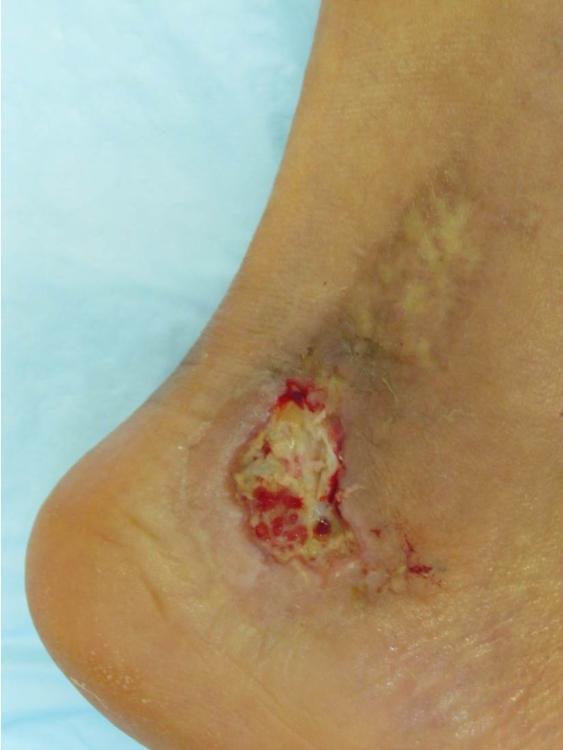

28-year-old female with sickle cell ulcer before and after treatment with CelluTome Epidermal Harvesting System
In chronic wounds such as diabetic ulcers, Dr. Kirsner said, the pathway by which factors released from the wound travel to the bone marrow and stimulate progenitor cells, causing stem cells to migrate to the wound, is perturbed. However, he said, case reports show that applying bone marrow-derived stem cells directly into a freshly debrided wound – via spray, injection or dressings – speeds healing while minimizing scarring.12
Similarly, one of the few RCTs in this area showed that placing MSCs into 18 diabetic ulcers led to statistically significant improvement versus placebo.13 As such, "There's a lot of potential here, using stem cells including bone marrow-derived stem cells to speed healing, and work is ongoing."
NEXT: 28-year-old female with sickle cell ulcer before and after treatment

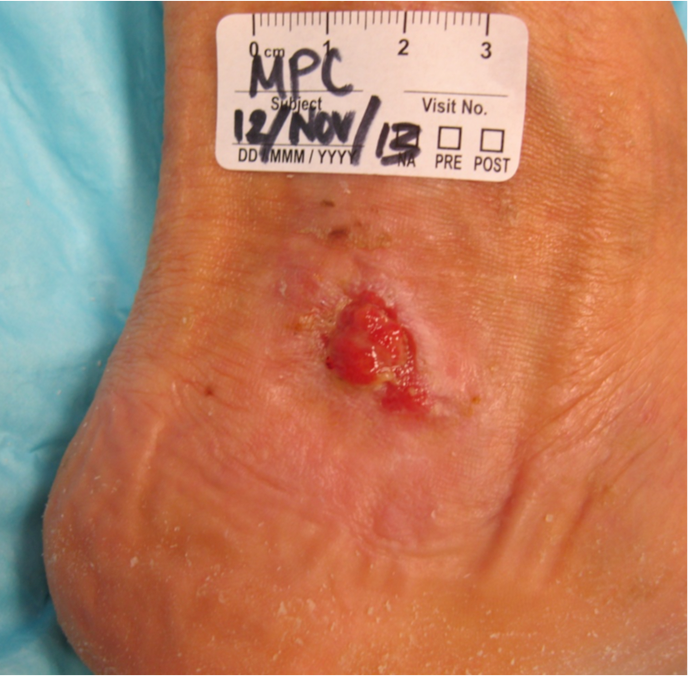

28-year-old female with sickle cell ulcer before and after treatment with CelluTome Epidermal Harvesting System
MSCs show particular potential because they're both anti-inflammatory and antifibrotic, Dr. Kirsner said. In one case report, injecting MSCs into a severe radiation burn at the time of surgery significantly improved scarring.14 A more recent study revealed how MSCs do this, he said. Once placed into a wound, he explained, they quickly die, releasing factors that improve scarring.15 "Work is underway to figure out exactly what those factors are. If we can identify them, maybe we don't even need the MSCs."
NEXT: Final results from treatment

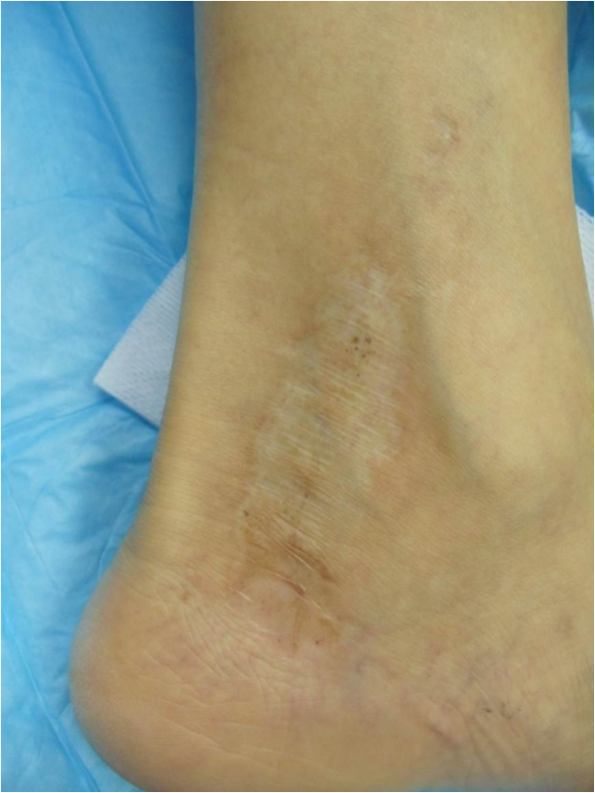

28-year-old female with sickle cell ulcer before and after treatment with CelluTome Epidermal Harvesting System
Presently, Dr. Kirsner's colleagues are evaluating mechanisms for delivering MSCs. In this regard, he said that laser-created channels appear more efficient than dressings, sprays or injections, particularly for burns and war wounds.
READ: Compression vital in management of venous leg ulcers
NEXT: Simple scar reduction
Simple scar reduction
For full-thickness surgical wounds, "The standard of care is to suture it closed. But often, we suture it closed, maybe apply a dressing, and believe our work is done." Even with optimal surgical technique, however, countertension may widen the scar over time.
To address this problem, Dr. Kirsner suggested considering Embrace Advanced Scar Therapy (Neodyne Biosciences), a commercially available dressing that is applied weekly for up to eight weeks, starting one week after surgery. "It's a simple tool to reduce postsurgical skin tension, which results in better scar formation." Injecting botulinum toxin type A may fulfill the same function, said Dr. Kirsner. Animal studies suggest this strategy works,16 "But the human studies are not yet robust."
NEXT: References
References
Dr. Kirsner is an advisor for Acelity.
1. Marucha PT, Kiecolt-Glaser JK, Favagehi M. Mucosal wound healing is impaired by examination stress. Psychosom Med. 1998 May-Jun;60(3):362-5.
2. Léauté-Labrèze C, Dumas de la Roque E, Hubiche T, Boralevi F, Thambo JB, Taïeb A. Propranolol for severe hemangiomas of infancy. N Engl J Med. 2008 Jun 12;358(24):2649-51. doi: 10.1056/NEJMc0708819.
3. Mohammadi AA, Bakhshaeekia A, Alibeigi P, et al. Efficacy of propranolol in wound healing for hospitalized burn patients. J Burn Care Res. 2009 Nov-Dec;30(6):1013-7. doi: 10.1097/BCR.0b013e3181b48600.
4. Tang JC, Dosal J, Kirsner RS. For topical timolol for a refractory wound. Dermatol Surg. 2012 Jan;38(1):135-8.
5. Braun LR, Lamel SA, Richmond NA, Kirsner RS. Topical timolol for recalcitrant wounds. JAMA Dermatol. 2013 Dec;149(12):1400-2. doi: 10.1001/jamadermatol.2013.7135.
6. Osborne SN, Schmidt MA, Derrick KL, Harper JR. Epidermal micrografts produced via an automated and minimally invasive tool form at the dermal-epidermal junction and contain proliferative cells that secrete wound-healing growth factors. Adv Skin Wound Care. (In press).
7. Richmond NA, Jamel SA, Braun LR, Vivas AC, Serena T, Kirsner RS. Epidermal grafting using a novel suction blister harvesting system for the treatment of pyoderma gangrenosum. JAMA Dermatol. Published online August 6, 2014. Accessed February 23, 2015.
8. Kirsner RS, Falanga V, Kerdel FA, Katz MH, Eaglstein WH. Skin grafts as pharmacological agents: pre-wounding of the donor site. Br J Dermatol. 1996 Aug;135(2):292-6.
9. Wilcox JR, Carter MJ, Covington S. Frequency of debridements and time to heal: a retrospective cohort study of 312,744 wounds. JAMA Dermatol. 2013 Sep;149(9):1050-8. doi: 10.1001/jamadermatol.2013.4960.
10. Brem H, Stojadinovic O, Diegelmann RF, et al. Molecular markers in patients with chronic wounds to guide surgical debridement. Mol Med. 2007 Jan-Feb;13(1-2):30-9.
11. Tomic-Canic M, Ayello EA, Stojadinovic O, Golinko MS, Brem H. Using gene transcription patterns (bar coding scans) to guide wound debridement and healing. Adv Skin Wound Care. 2008 Oct;21(10):487-92; quiz 493-4. doi: 10.1097/01.ASW.0000323563.59885.1c.
12. Badiavas EV, Falanga V. Treatment of chronic wounds with bone marrow-derived cells. Arch Dermatol. 2003 Apr;139(4):510-6.
13. Dash NR, Dash SN, Routray P, Mohapatra S, Mohapatra PC. Targeting nonhealing ulcers of lower extremity in human through autologous bone marrow-derived mesenchymal stem cells. Rejuvenation Res. 2009 Oct;12(5):359-66. doi: 10.1089/rej.2009.0872.
14. Bey E, Prat M, Duhamel P, et al. Emerging therapy for improving wound repair of severe radiation burns using local bone marrow-derived stem cell administrations. Wound Repair Regen. 2010. 18:50-58. doi: 10.1111/j.1524-475X.2009.00562.x.
15. Liu S, Jiang L, Li H, et al. Mesenchymal Stem Cells Prevent Hypertrophic Scar Formation via Inflammatory Regulation when Undergoing Apoptosis. J Invest Dermatol. 2014. 134: 2648–2657. doi:10.1038/jid.2014.169. Published online May 29, 2014.
16. Lee BJ, Jeong JH, Wang SG, Lee JC, Goh EK, Kim HW. Effect of botulinum toxin type A on a rat surgical wound model. Clin Exp Otorhinolaryngol. 2009 Mar;2(1):20-7. doi: 10.3342/ceo.2009.2.1.20. Epub 2009 Mar 26.





